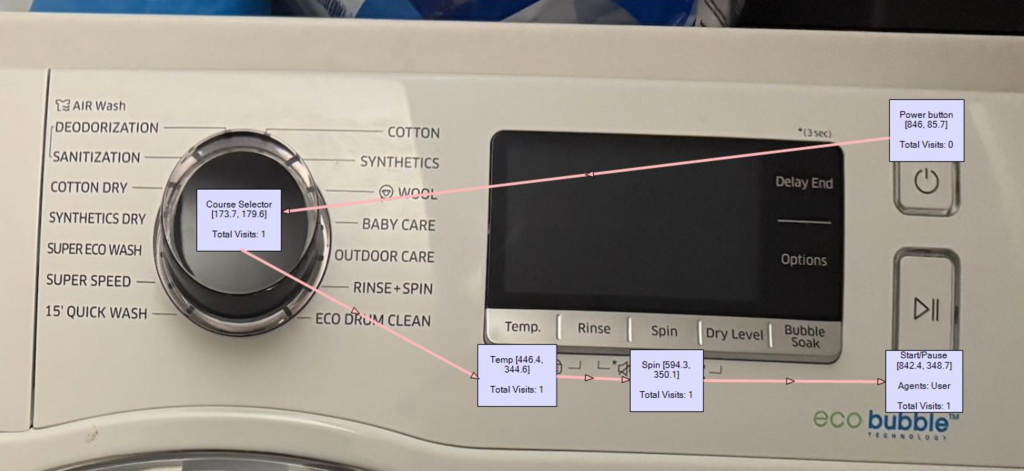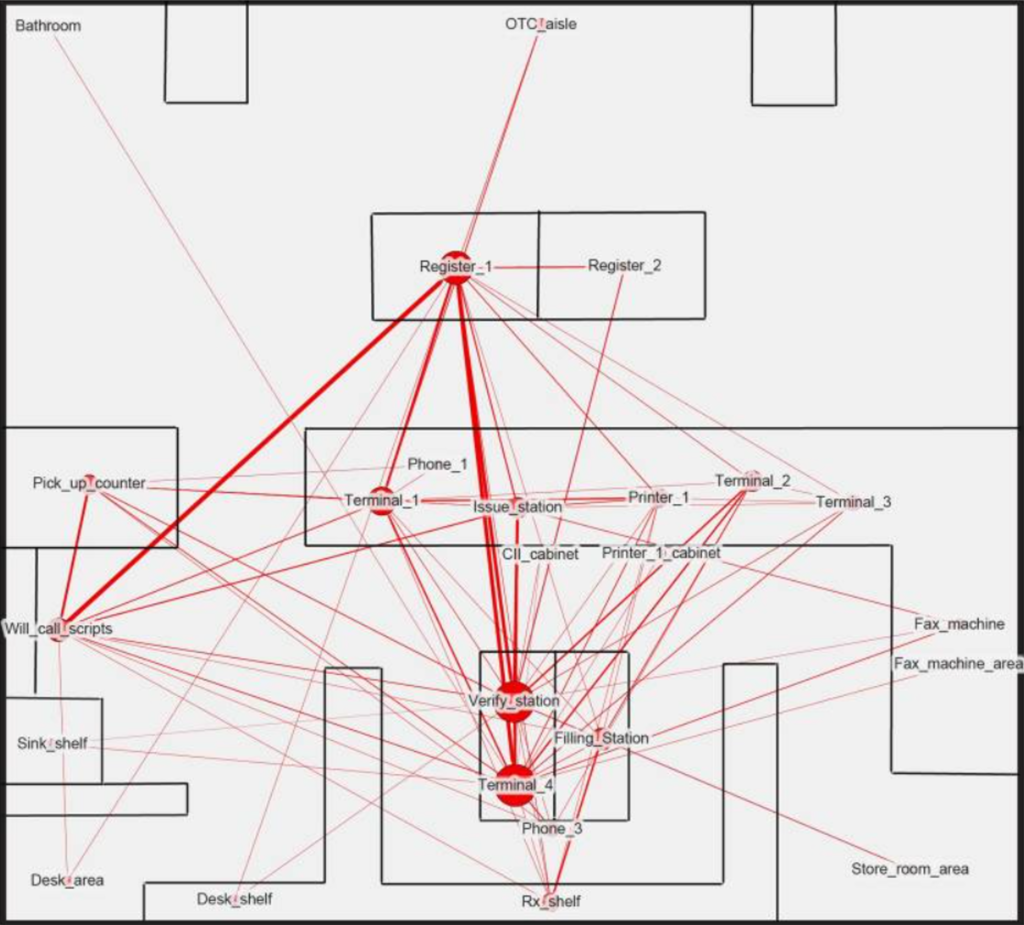During my MSc, one of my assignments involved using Link Analysis to evaluate the usability of an interface. In this blog, I wanted to revisit this assignment using the Link Analysis function in SHERPA, and some of the things I have since learnt while working in industry.
What is Link Analysis
Link Analysis is a tool used to understand the relationship between different entities, such as people and equipment, by visualising these interactions in a network. This technique helps detect patterns, highlight critical interactions, and identify areas of improvement. It is a popular tool used in different industries like cybersecurity, intelligence, and user experience (UX) design. In UX design, link analysis is mainly used to enhance product usability by mapping the user’s interaction, e.g. things that are used frequently together could be co-located.
The Analysis
For the analysis, I will use the Link Analysis to evaluate the usability of my washing machine’s interface.
Hierarchical Task Analysis
To start my analysis, I represented the process in a Hierarchical Task Analysis (HTA). This is to ensure that I captured all the steps throughout my task. For my usual laundry routine, I would turn on the washing machine after loading my clothes and putting a laundry pod into the drum. Then, I would select the ‘Super Speed’ program and adjust the temperature to 30°C and spin speed to 1200rpm. Once that’s completed, I will press ‘Start’ to start the washing cycle and wait for confirmation that the washing cycle has begun.

In my HTA above, I’ve also added two attributes – “Where” and “Agent/Person.” This helps me define the location of where each step was carried out (“Where”) and demonstrate who is performing the step (“Agent/Person”). Both these attributes are especially useful when we analyse larger scenarios involving different individuals and locations because we get to see the actions of each unique individual and how they interact with other people’s actions.
Link Analysis
We can conduct the link analysis once the HTA is completed and attributes assigned.

The analysis allowed me to visualise my pathway while using the washing machine. The purple boxes indicate where my actions took place (this was superimposed on an image of the interface), and the pink arrows illustrate the sequence of actions and movement between the different locations.
Starting from the top right part of the washing machine, I turned the machine on and moved across to the big dial to select the program. Then, I moved to the lower right part to adjust the settings, like the temperature and spin speed, before starting the cycle.
Because of where the buttons were placed, it felt like I was making a loop with my right hand, and moving from one location to the next felt natural without needing to switch hands. There were also no repetitive movements or revisits to any previous location, making setting up the washing cycle a smooth process. All of these design features made it very intuitive to use the washing machine, and it felt very efficient.
Applying Link Analysis to different scenarios
There are also broader applications for Link Analysis. Besides improving equipment usability, we can use it to understand people’s workflow within systems. Variations of Link Analysis have been used to identify potential cybersecurity threats1, improve community engagement2, and improve flight efficiency3.
In Human Factors, we can also apply Link Analysis to enhance human performance within a physical environment. By mapping out how people interact with equipment and other personnel, we can identify critical pathways and improve a room’s usability for efficient operations4,5,6. If two pieces of equipment were found to be placed far apart, for example, then their placement could be adjusted to streamline the task.

[Source: https://pmc.ncbi.nlm.nih.gov/articles/PMC4826624/]
This concept is echoed in Topic 2 of the Human Factors Delivery Guide for COMAH, Human Factors in Process Design, which describes the importance of adopting a user-centred approach when designing plants, equipment, and control rooms. Link Analysis is highly relevant in this case, as we can identify the most efficient room design and understand the usability of both equipment and software interface. The Engineering Equipment and Materials Users Association (EEMUA) guidance on control room design (EEMUA 201) also supports using Link Analysis to adopt a user-centred approach when planning a control room.
Link Analysis is an effective and versatile tool that should be integral to the design process. Its simplicity allows it to be applied across a wide variety of contexts, from evaluating machine interfaces to designing physical environments. By visualising workflows and focusing on the users’ perspective, Link Analysis enhances usability and ensures sustainable and efficient solutions for improving usability and creating more intuitive designs.
The Link Analysis was conducted using the SHERPA software. If you are interested in learning how you can do your own Link Analysis on the SHERPA software, get in touch with us today.
Our team of experienced consultants offers comprehensive services tailored to meet your Human Factors needs. To learn more about how we can support your requirements, click here.
Bibliography
- Pelofske E, Liebrock LM, Urias V. Cybersecurity Threat Hunting and Vulnerability Analysis Using a Neo4j Graph Database of Open Source Intelligence. arXiv Preprint. 2023. https://arxiv.org/abs/2301.12013
- Owen JE, Curran M, Bantum EO, Hanneman R. Characterizing Social Networks and Communication Channels in a Web-Based Peer Support Intervention. Cyberpsychology, Behavior, and Social Networking. 2016;19(6):388-396. doi: https://doi.org/10.1089/cyber.2015.0359
- Justavino RA, Gruenheid R, Bauch G, Wolff F, Heide S v. d. Link Analysis Between an Airborne Mobile Station and a Terrestrial GSM Network. SCC 2017; 11th International ITG Conference on Systems, Communications and Coding. 2017. https://ieeexplore.ieee.org/document/7938039
- Lester CA, Chui MA. Using Link Analysis to Explore the Impact of the Physical Environment on Pharmacist Tasks. Research in social & administrative pharmacy: RSAP. 2016;12(4):627-632. doi: https://doi.org/10.1016/j.sapharm.2015.09.011
- Kobir MH, Rahman T, Yang Y, Deb S. A Human Factors Approach to Improve Layout Design for a Virtual Reality-based Training Platform. Proceedings of the Human Factors and Ergonomics Society Annual Meeting. 2023;67(1):1439-1444. doi: https://doi.org/10.1177/21695067231192657
- Dinakar S, Tippey KG, Roady T, Edery J, Ferris TK. Using Modern Social Network Techniques to Expand Link Analysis in a Nuclear Reactor Console Redesign. Proceedings of the Human Factors and Ergonomics Society Annual Meeting. 2016;60(1):1083-1087. doi: https://doi.org/10.1177/1541931213601250














